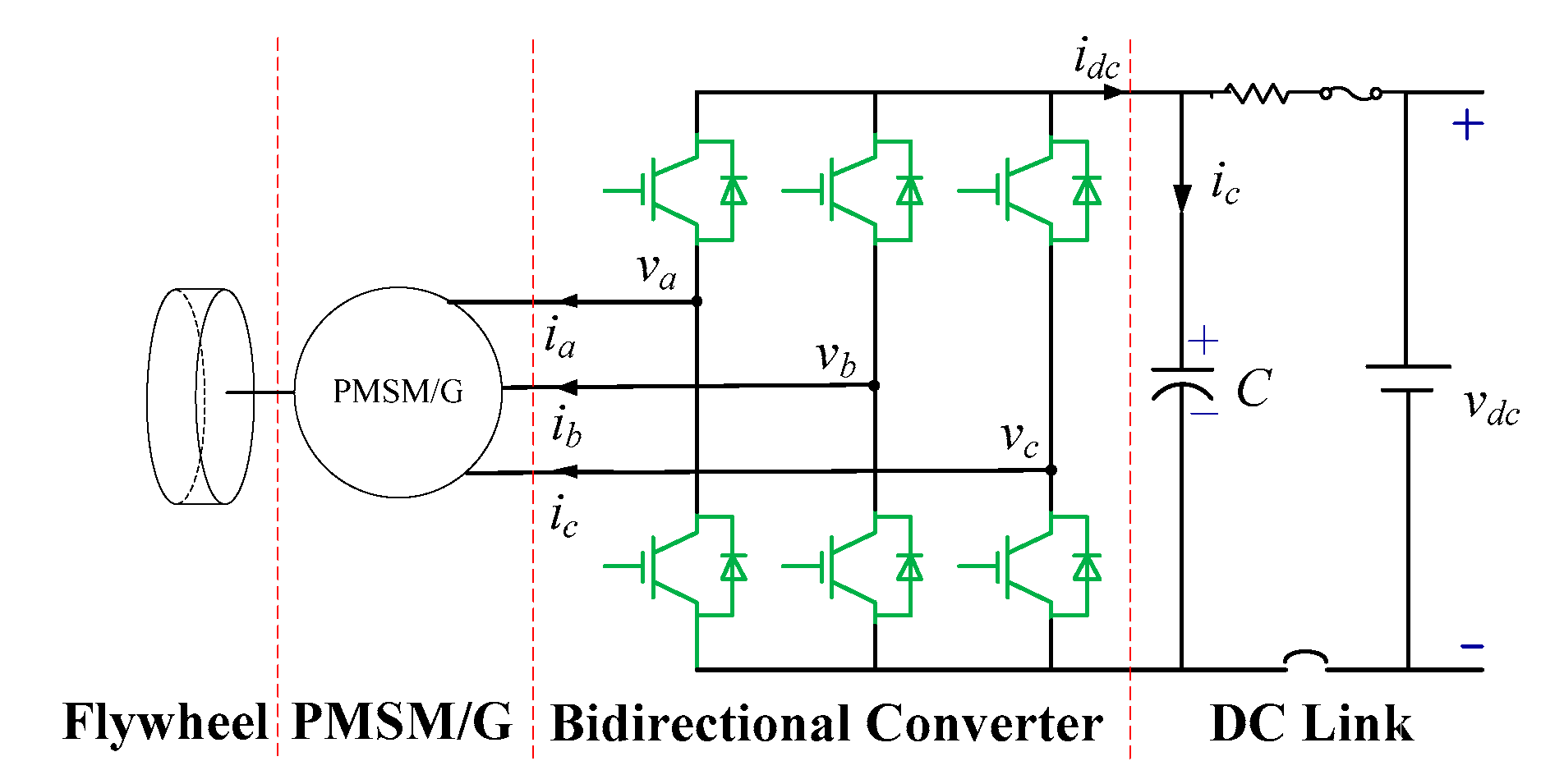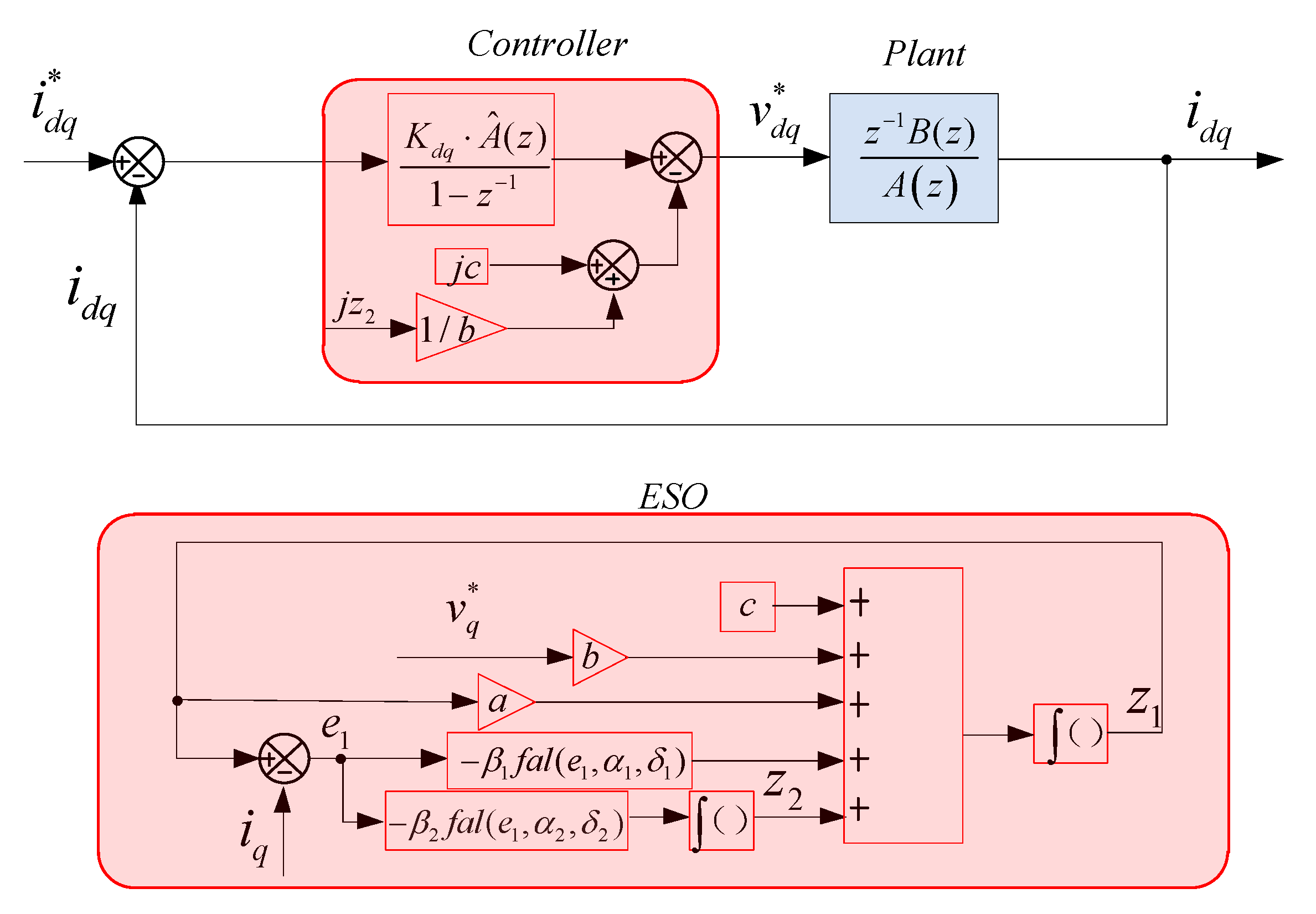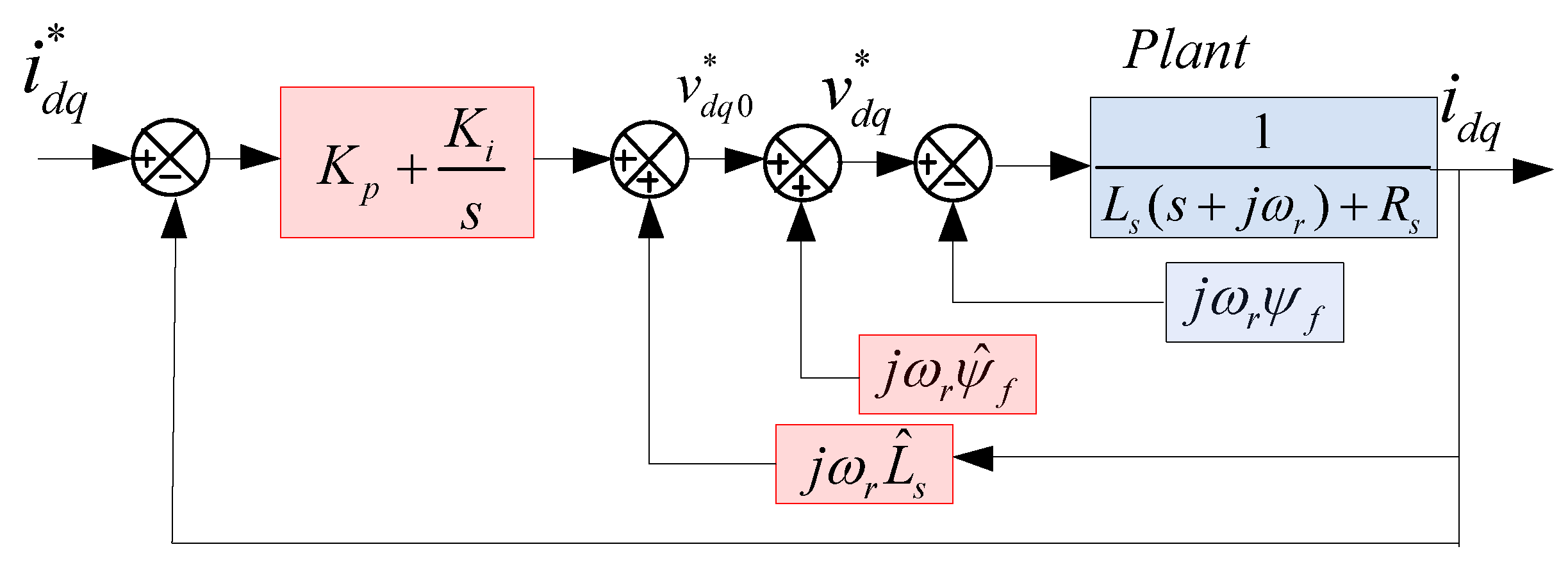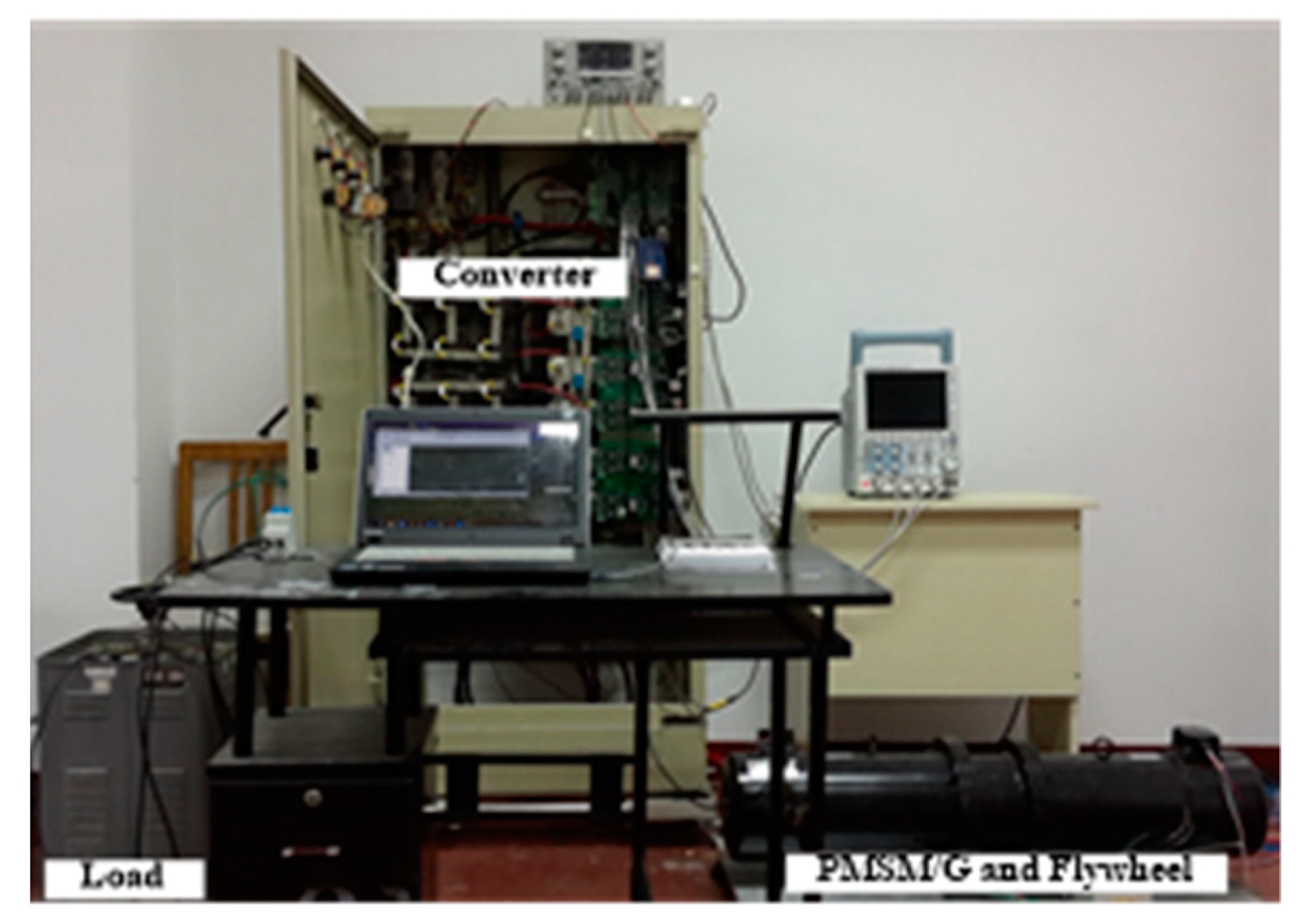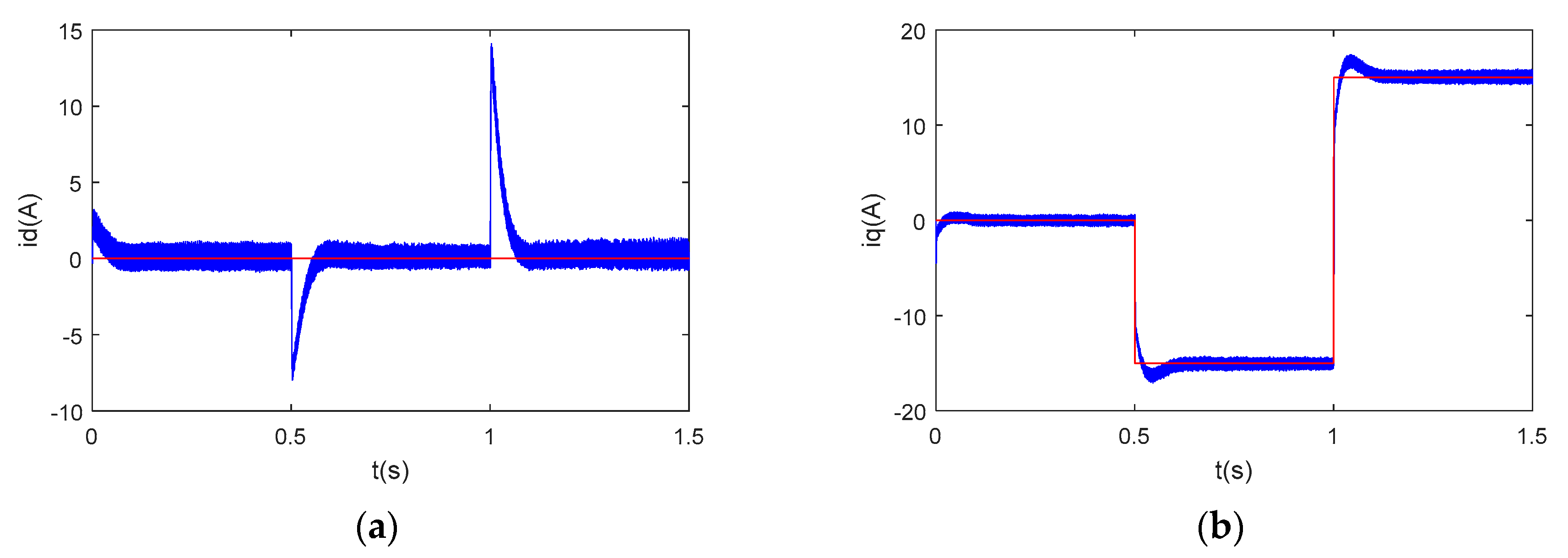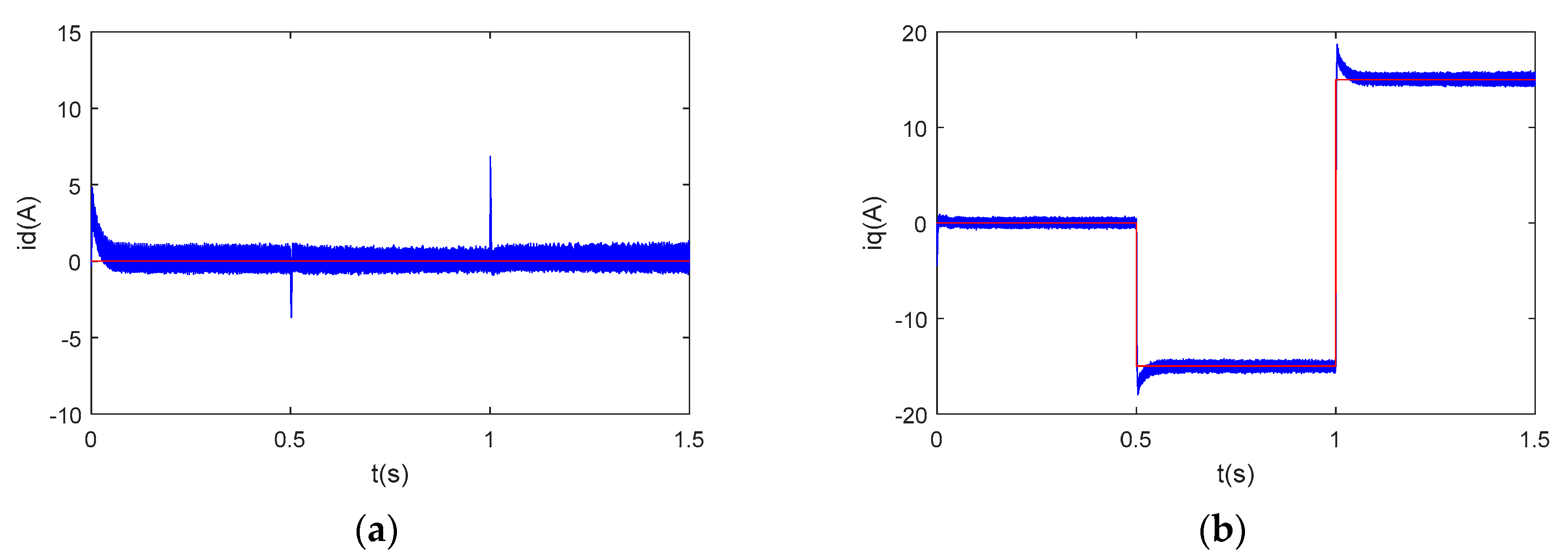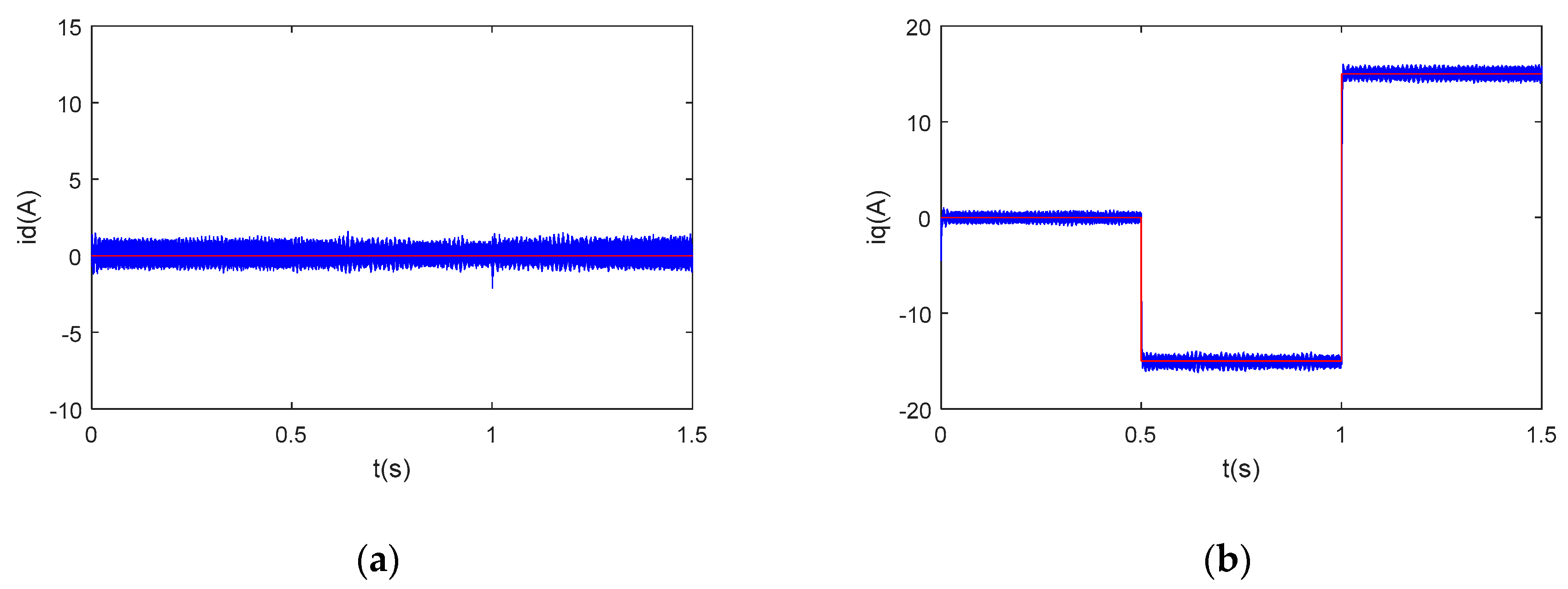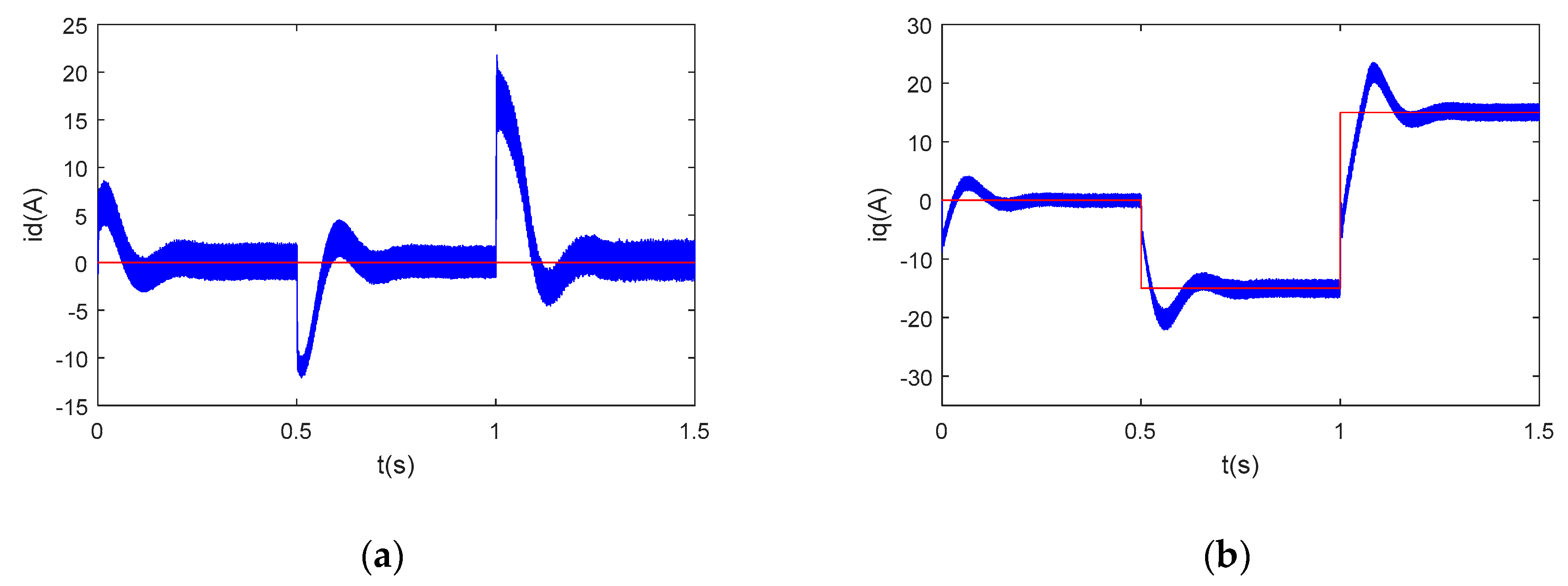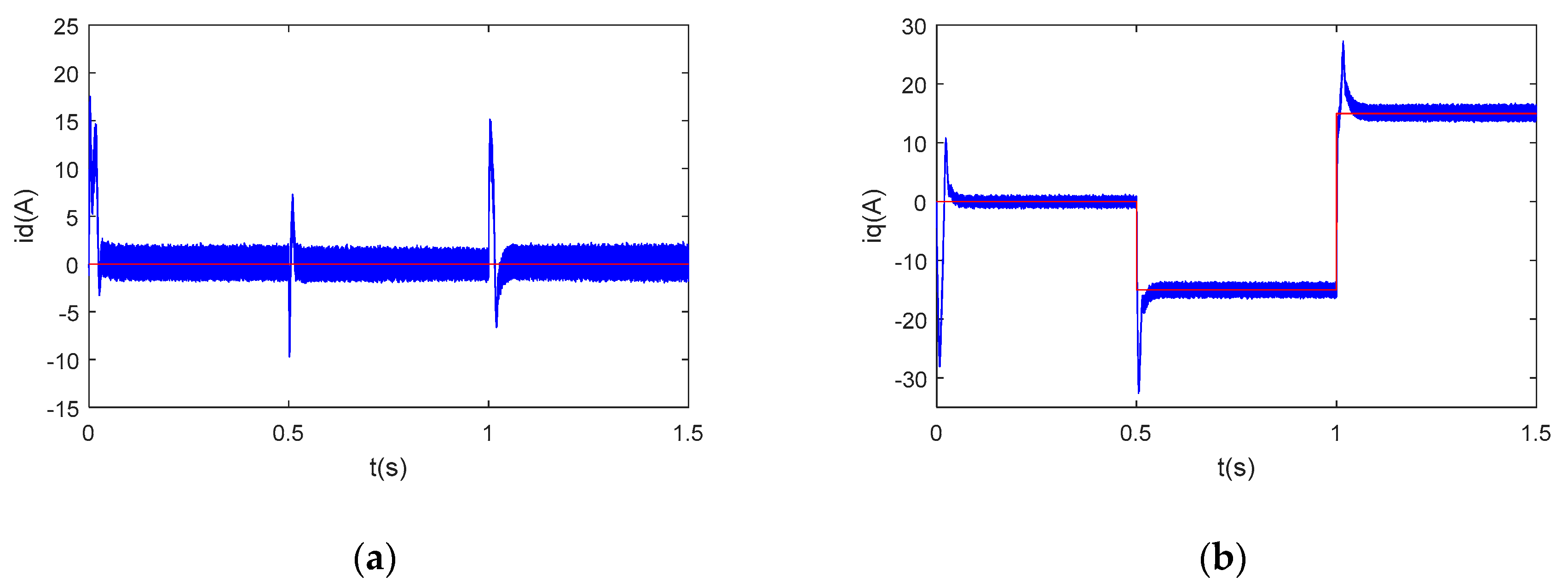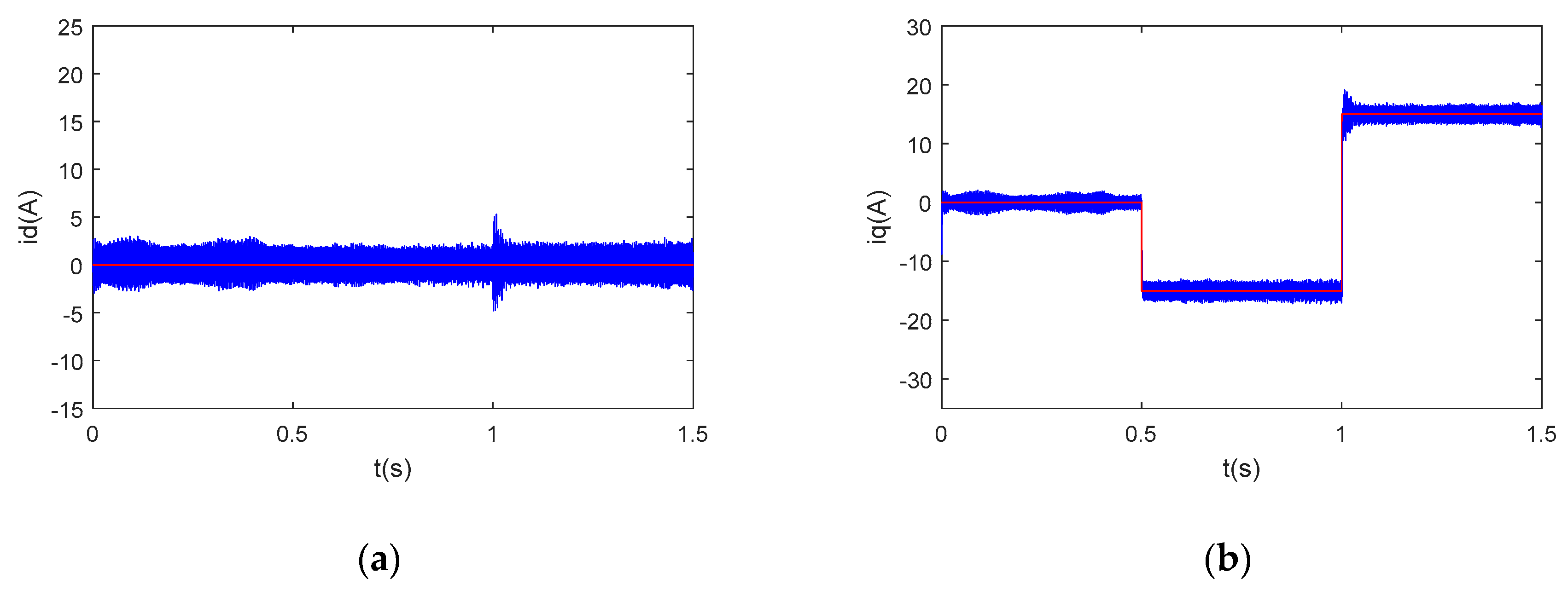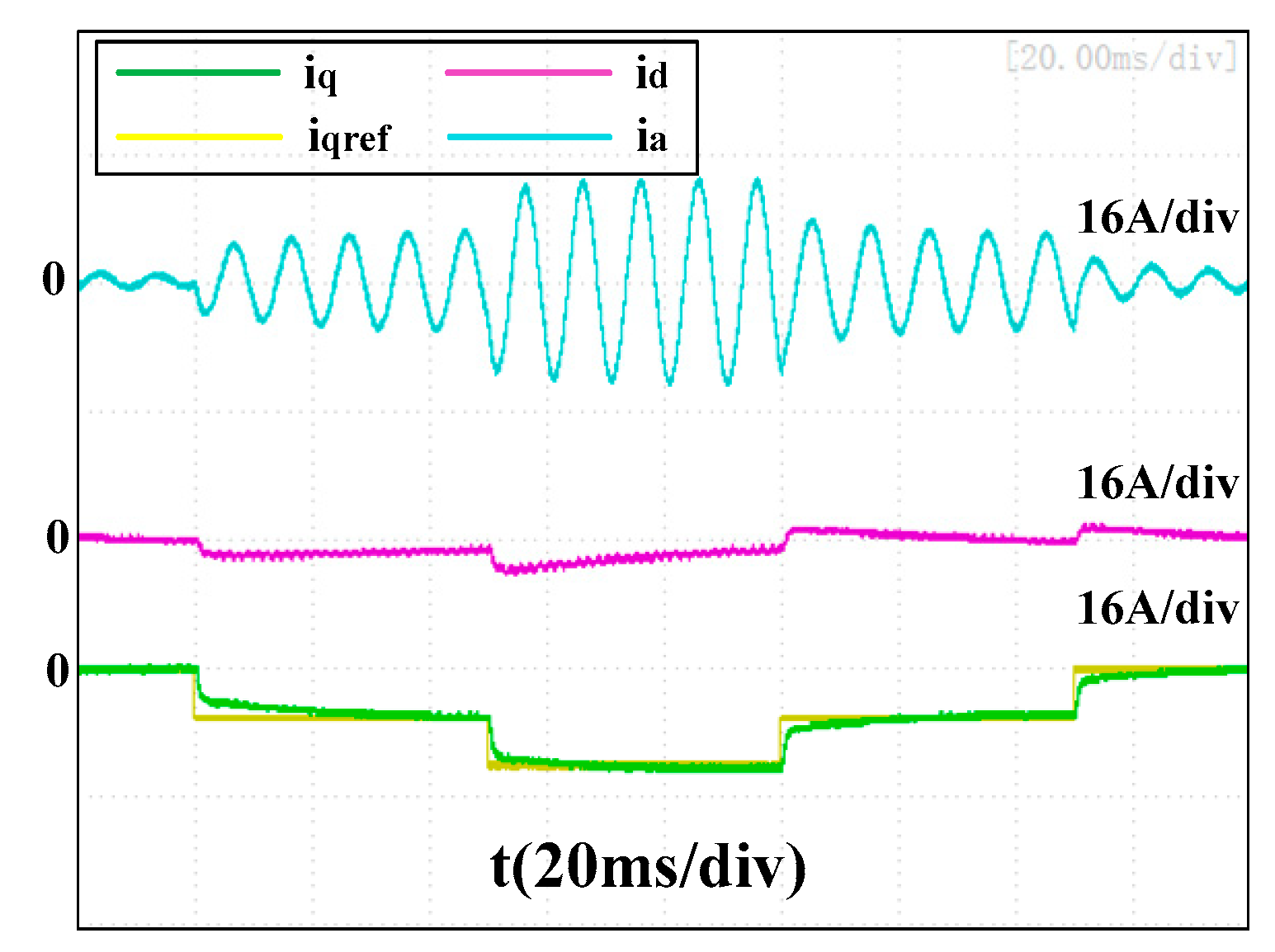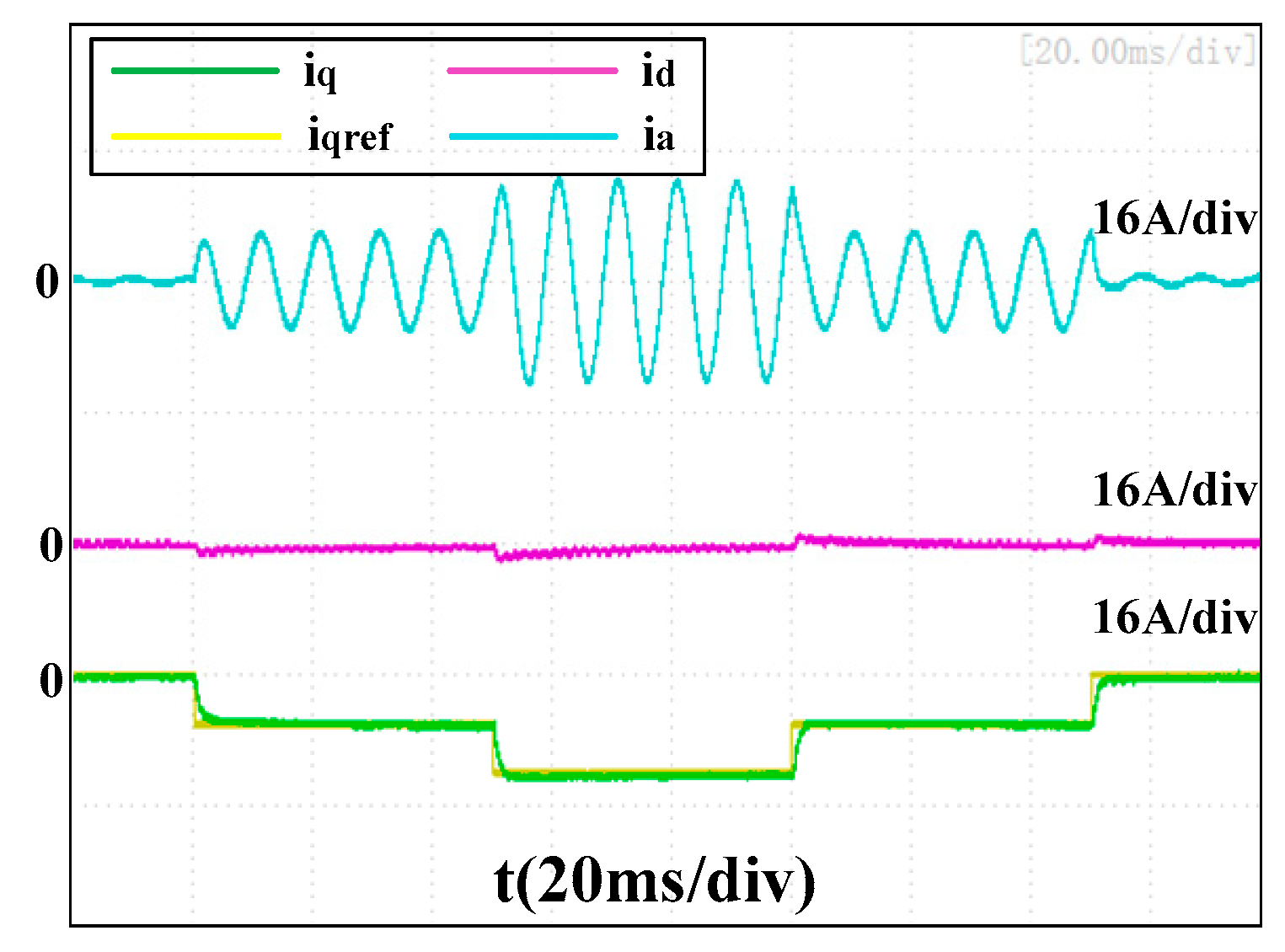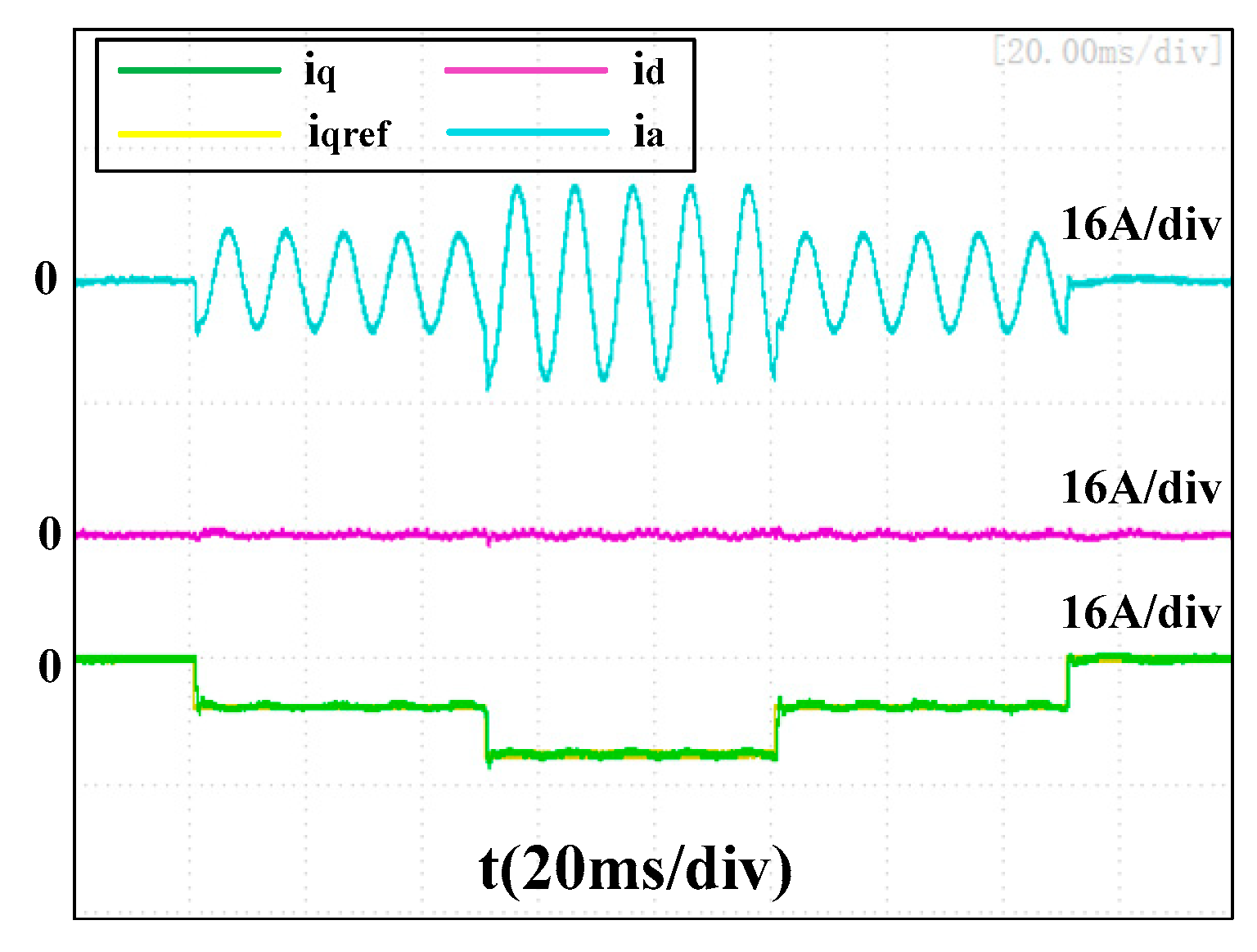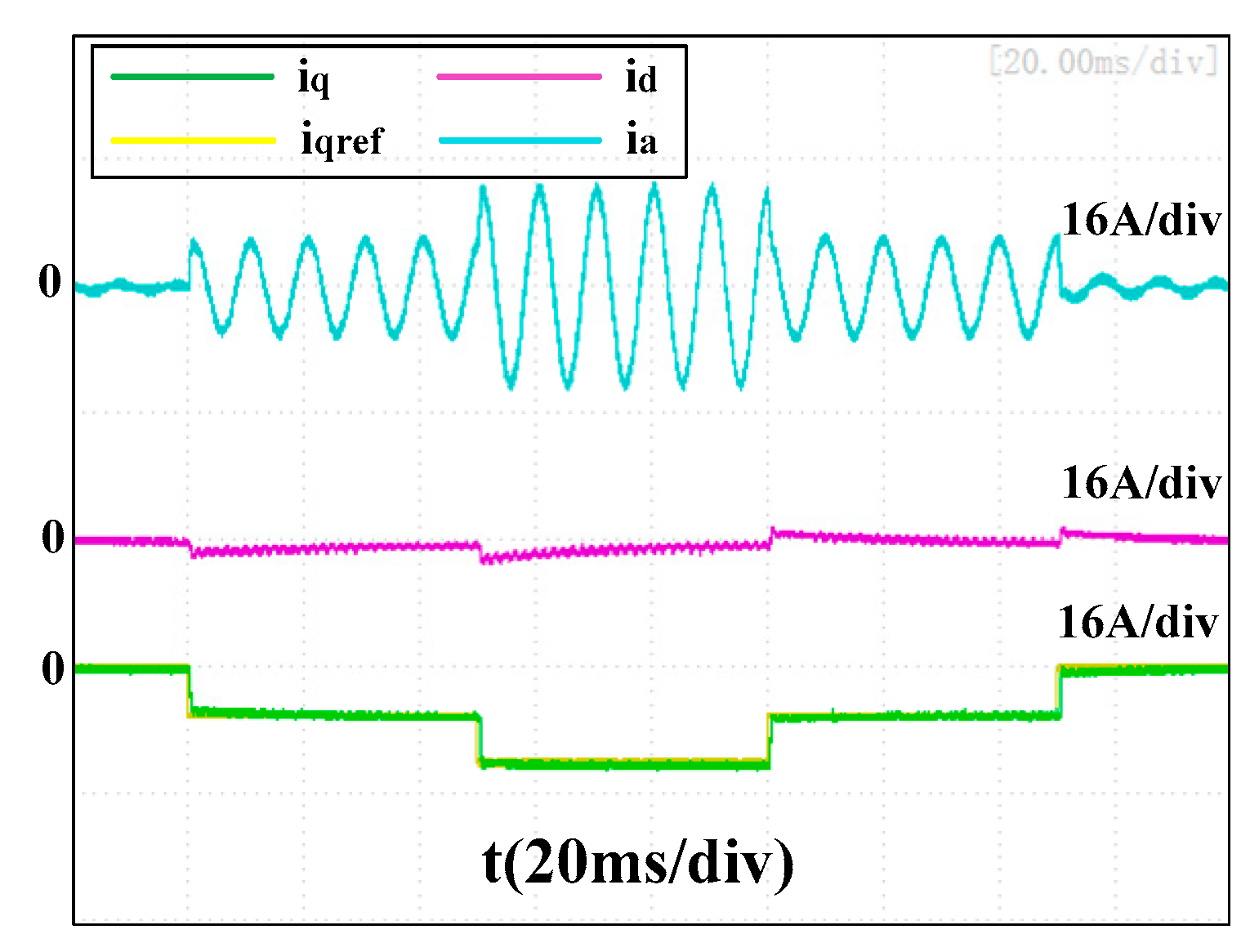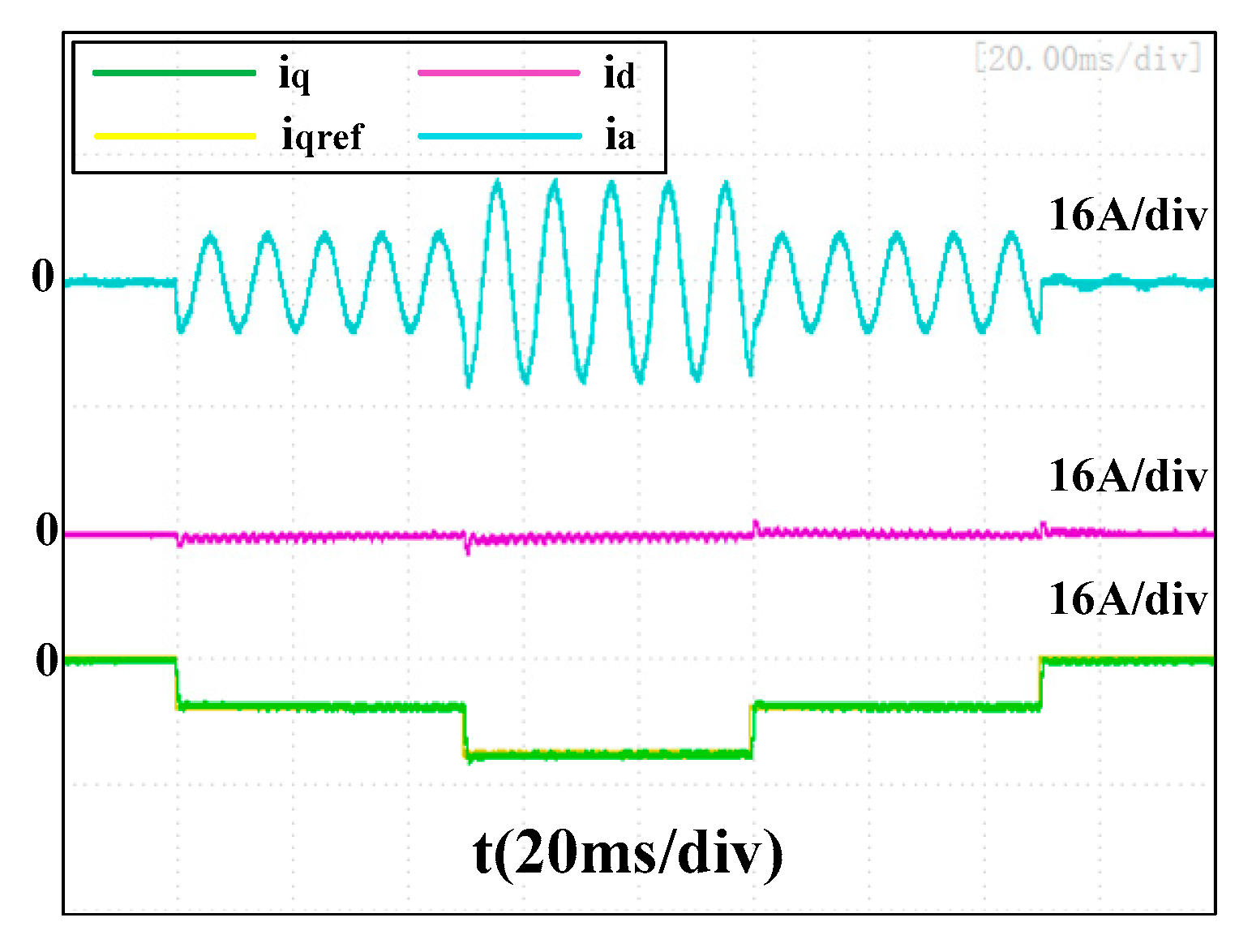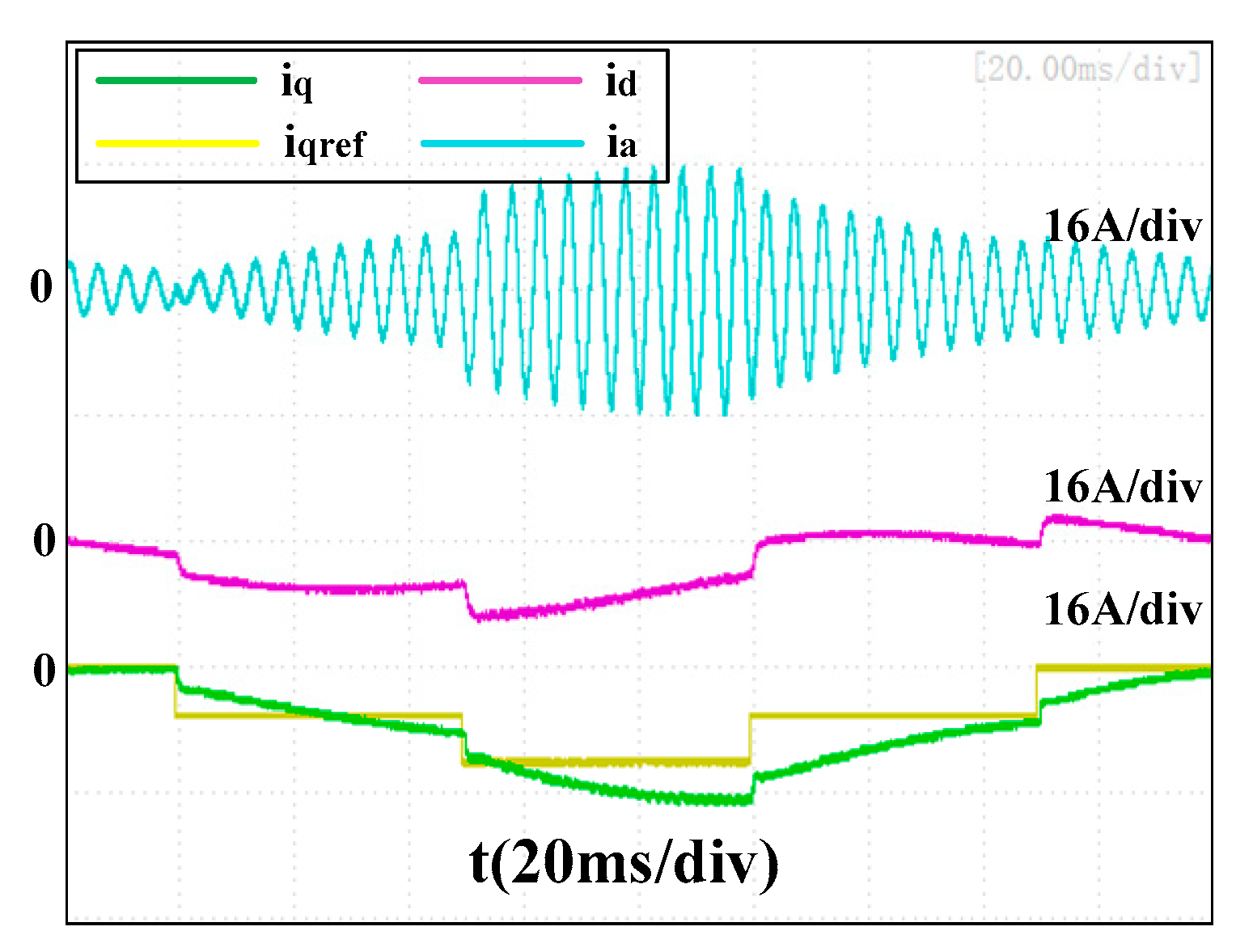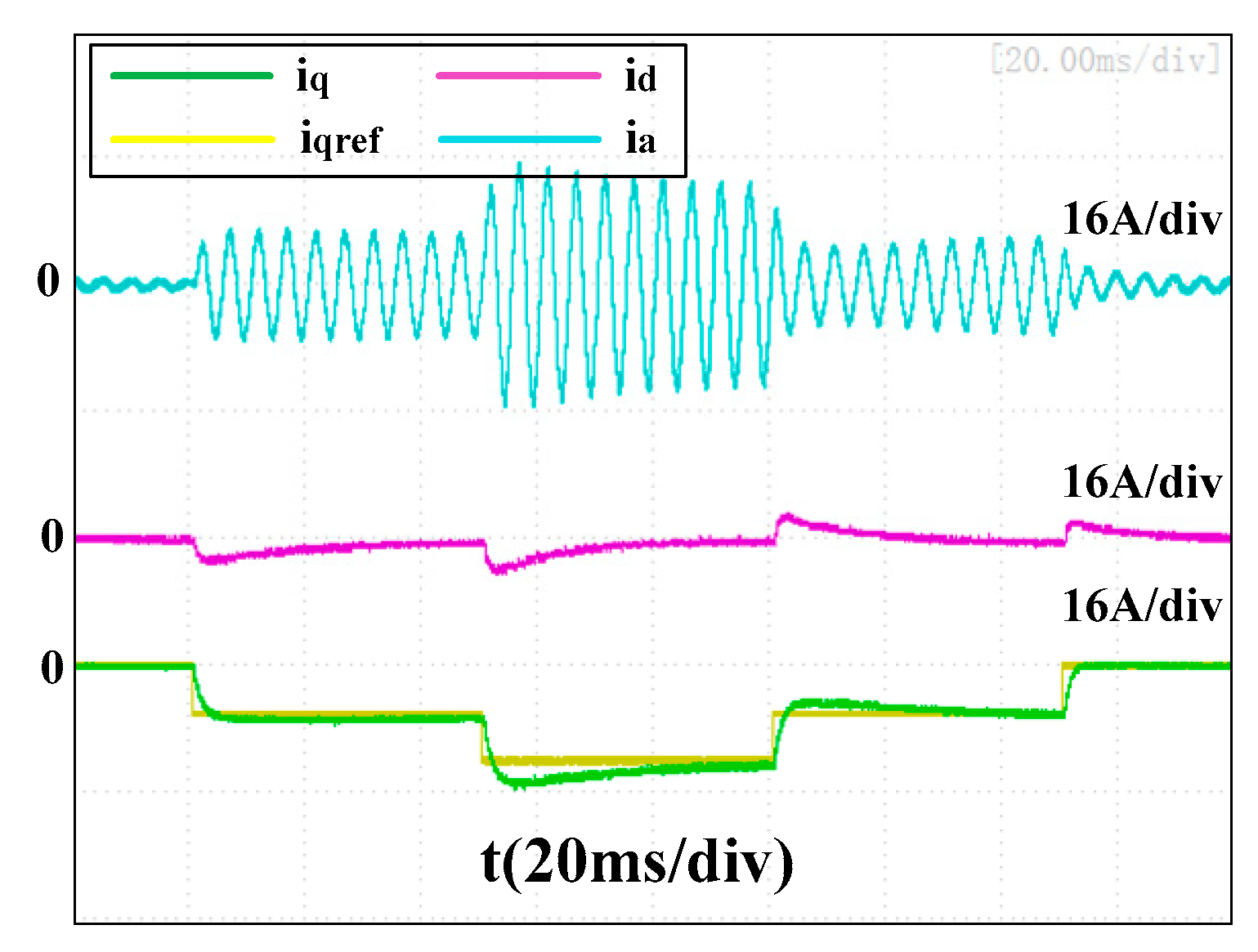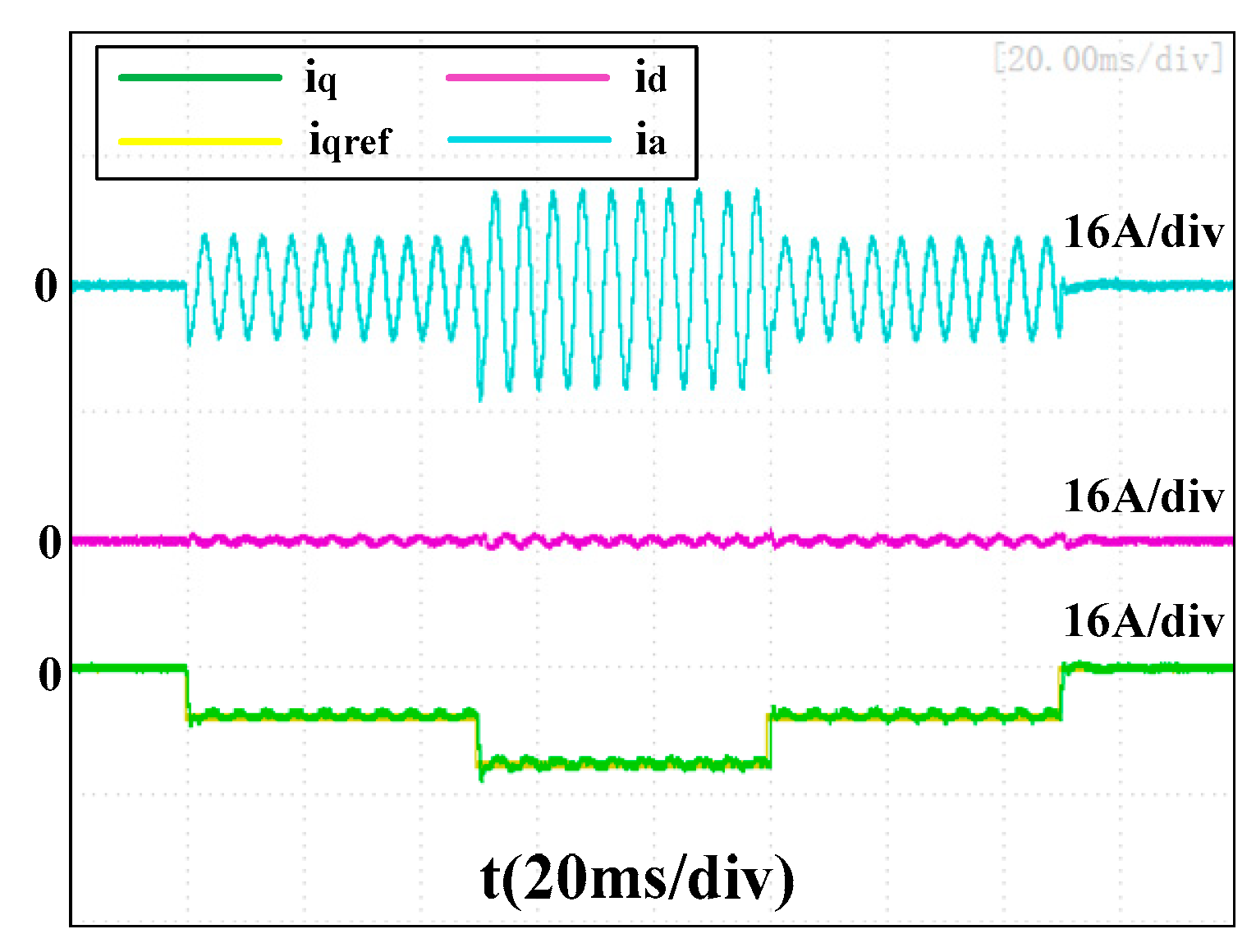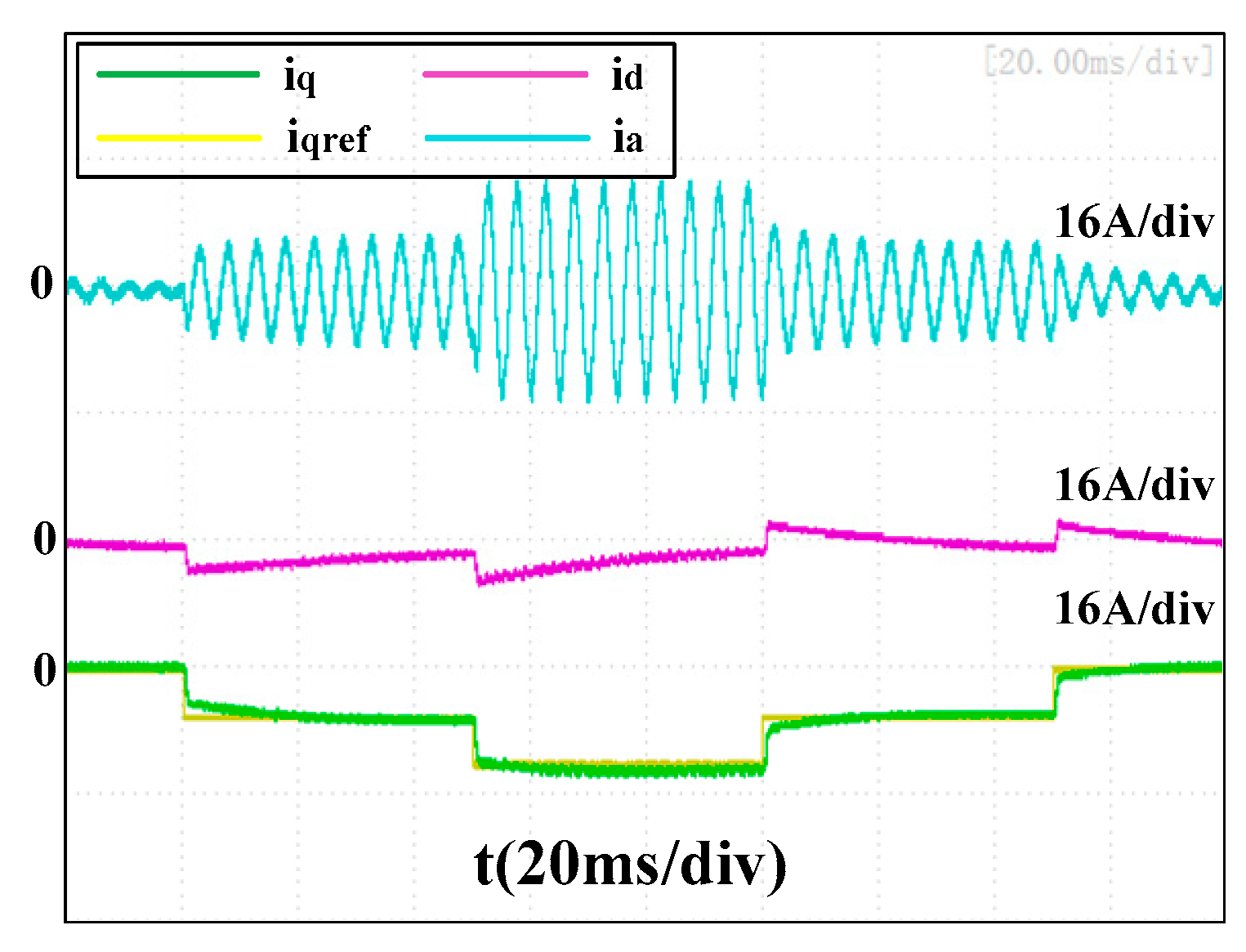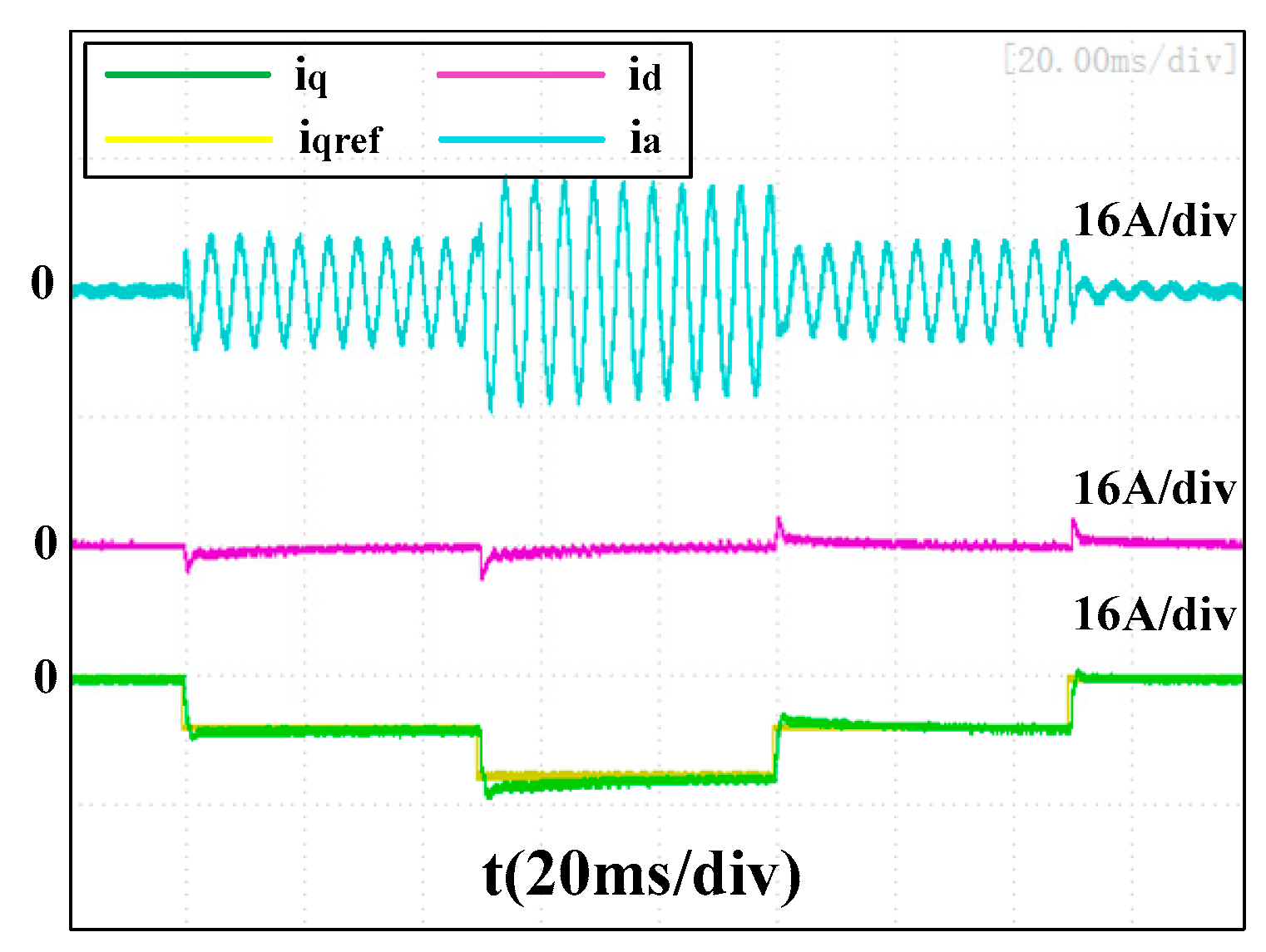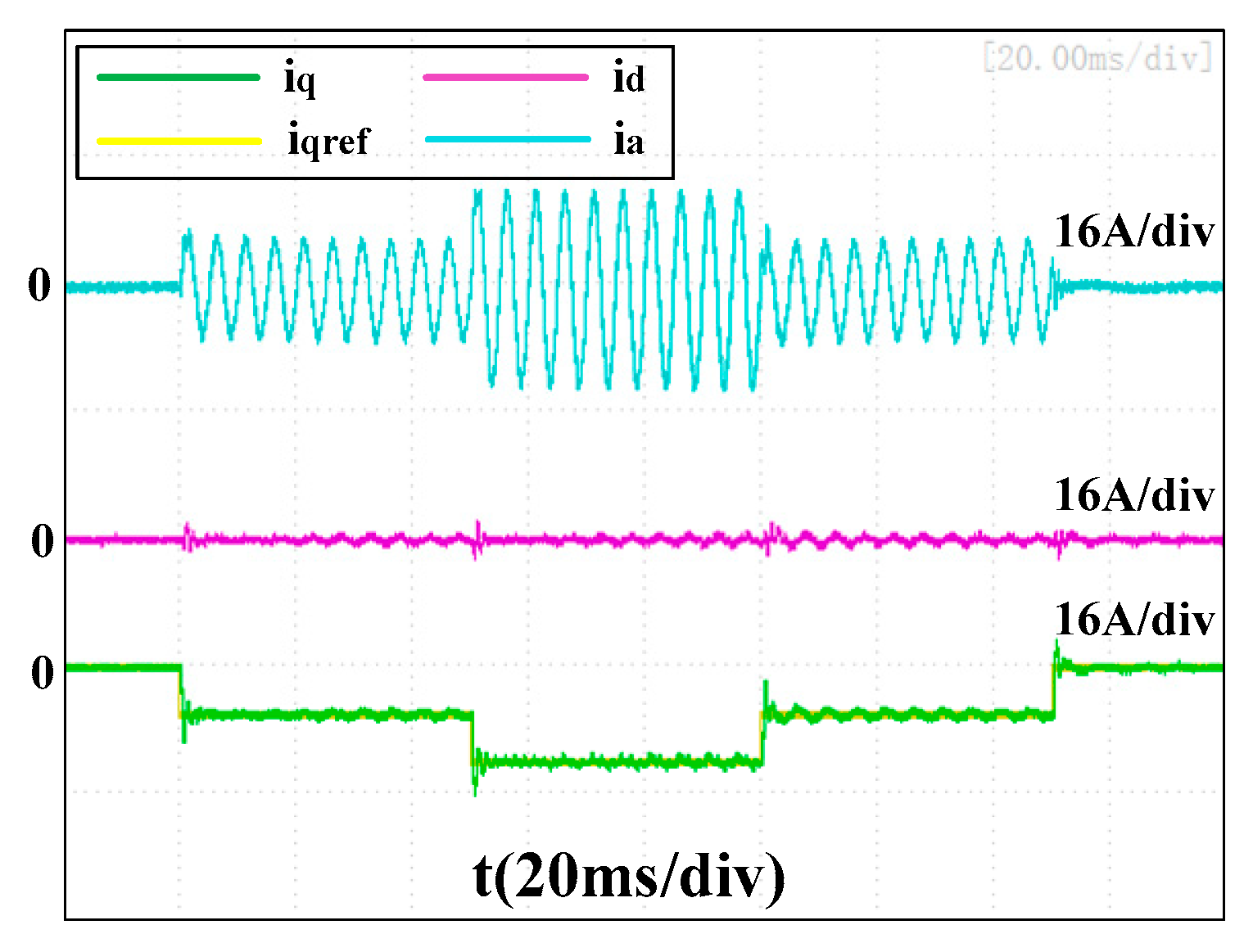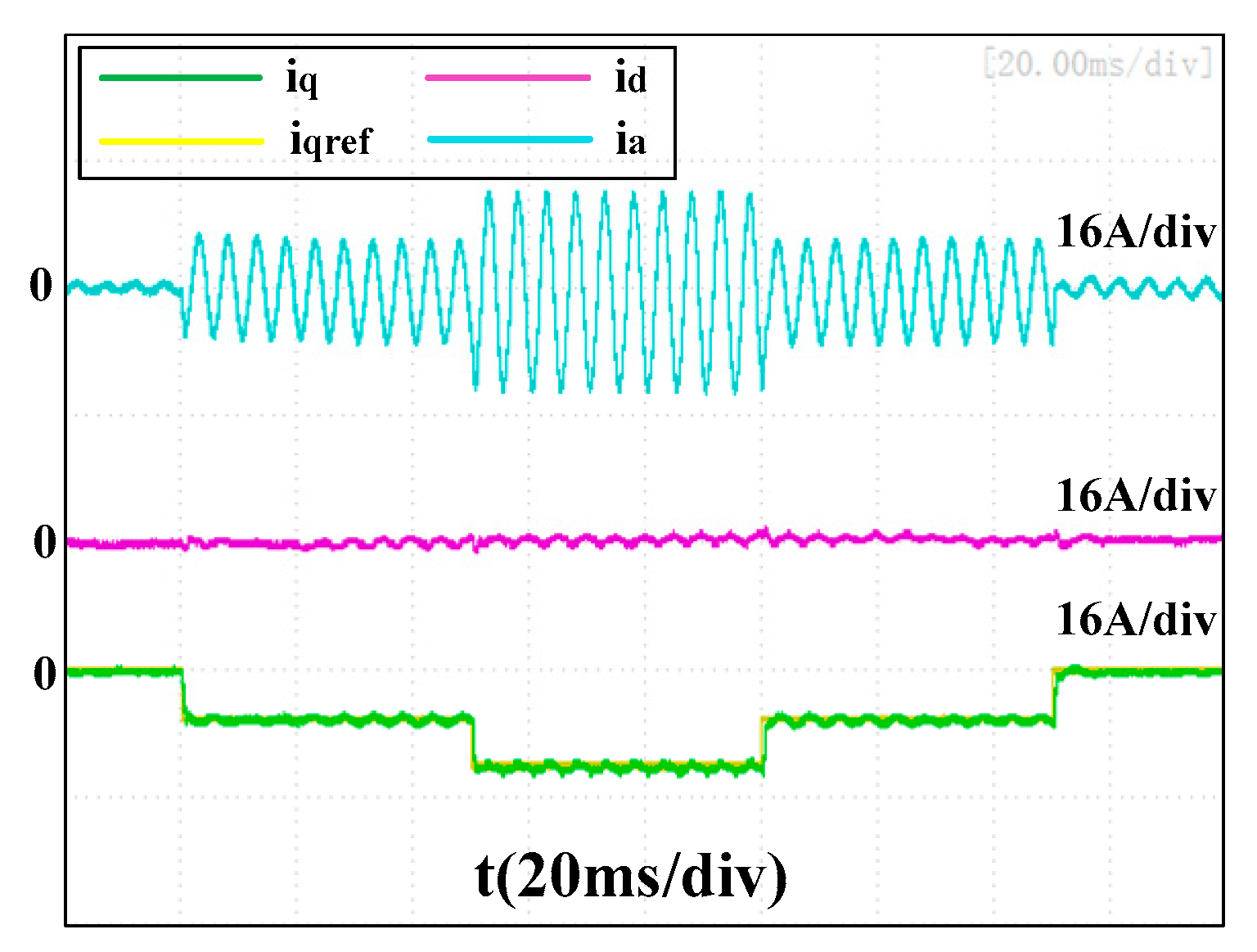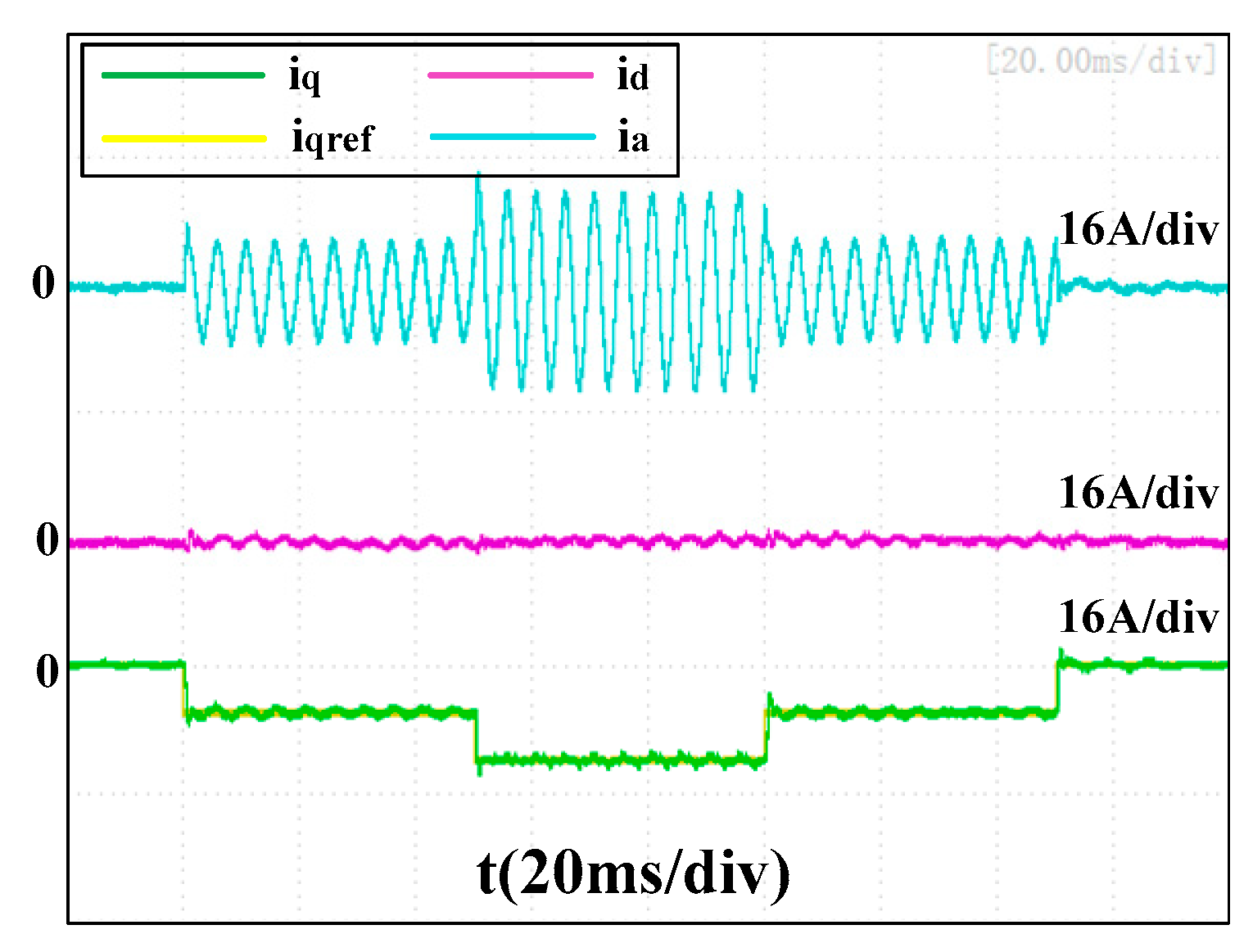1. Introduction
A Flywheel Energy Storage System (FESS) is a mechanical energy storage system that stores energy through a high-speed rotational flywheel driven by an integrated motor/generator and a power converter [
1]. Due to its high-energy transfer efficiency, high instantaneous power, fast dynamic response, long cycle lifetime, and low pollution to environments [
2,
3], the application of FESS has been widely researched within a wide range of fields including electrical vehicles, naval warships, aerospace applications, micro grids, wind power plants, and so on [
4,
5,
6,
7].
The High-speed Permanent Magnet Synchronous Motor/Generator (PMSM/G) is a good candidate for the FESS machine thanks to its efficiency, power density, reliability, and flexibility of bidirectional power flow [
8]. However, the high speed leads to a high cross-coupling voltage between d-q axes current loops, which leads to transient errors during dynamic process. Moreover, the wide speed range operation of the high-speed PMSM/G and the switching frequency limitation of power electronic devices results in low switching-to-fundamental-frequency ratios. At low ratios, oscillation or instability can be caused by high cross-coupling between d-q axis currents and intolerable digital delays between the variable sampling and reference signal implementation if the discrete nature of the Pulse Width Modulation (PWM) modulation method is not properly considered during the current controller design [
9].
To solve the cross-coupling problem, the most direct and commonly used decoupling method is the state feedback method, which calculates and compensates cross-coupling terms according to the sampled current and speed in the current controller [
10,
11]. However, the drawback is that the calculation of decoupling terms is highly dependent on inductance parameters. With the intolerant sampling delays, the effectiveness of the decoupling is greatly reduced. Another commonly used decoupling method is based on the complex vector model [
12], the essence of which is zero-pole cancellation. The final compensation term comes from the output of an integrator, so the requirement for the parameter accuracy is reduced, and the robustness to the parameter perturbation is enhanced. The drawback is that the oscillation of synchronous frequencies is superimposed on the transient current waveform before the controller enters a steady state [
13]. Two Proportional-Integral (PI) cross-decoupling terms are used in [
14] to compensate the reference voltage, which improved the robustness, but the bandwidth of the current controller needs to be increased to ensure the current tracking performance, resulting in a larger noise in the output voltage of the current controller. A sliding mode control decoupling algorithm is proposed in [
15] that improves the robustness of the system to the parameter variation to a certain extent, but also induced the chattering problem.
All the methods above are discussed in the continuous time domain, where a current controller is normally designed based on a continuous model. When applied to discrete control systems, the controller has to be transferred to its discrete form though approximation methods, among which the Euler difference method and Tustin transformation are the most widely used options. However, inevitable performance degradation occurs because the intrinsic delay of the digital controller is not taken in to consideration during the design procedure, which results in sensitivity to the rotation speed [
16,
17].
The digital delays can be roughly modeled with a first-order low-pass filter with a time constant of 3Ts/2 [
18], but this approach is only reasonable when the digital delays are much smaller than the fundamental period of the electrical machines [
19]. However, when faced with lower switching-to-fundamental-frequency ratios, the magnitude and phase errors generated during the sampling period should be analyzed though a more complex and accurate model such as a higher-order Padé approximations [
20,
21].
In our previous conference publication [
22], an accurate discrete current loop model with a complex vector expression was built, and an accurate discrete controller was designed that accounted for the magnitude and phase errors generated during the sampling period. This allowed classical analysis tools to be applied in the stability and performance evaluation of a closed-loop system in discrete time [
23,
24], but the elaboration was not complete and the rough simulation and experimental results given were based on a low-speed machine with a switching frequency of 5 kHz and fundamental frequency of 50 Hz at 1000 rpm, which was not convincing enough. Following the work in [
13], an Extended State Observer (ESO) was added in the current loop to estimate and compensate the back-Electromotive Force (back-EMF) error in this paper, and simulation and experimental results were obtained on a real high-speed PMSM/G prototype with rated speed of 12,000 rpm.
The controller design and performance analysis are presented in
Section 2. Simulation and experiment validation are presented in
Section 3 and
Section 4. Finally, a conclusion is drawn in
Section 5.
3. Simulation Results
Performance of the proposed current controller (Equation (20)) was compared with the discrete form (Equation (22)) of the conventional controller with and without feedback decoupling term
using MATLAB/SIMUINK simulations. The parameters of the PMSM/G and converter obtained from a high-speed prototype in
Figure 4 are listed in
Table 1.
The switching frequency was set to 2.5 kHz in the simulation, but kept as 5.0 kHz in the experiments. The bandwidth f
cl of three controllers was set as 500 Hz. For comparison, simulation results of the current controllers without decoupling and with state feedback decoupling are presented. The PMSM/G worked in generation mode at a constant speed. The DC link was fed by a DC voltage source, and no load was connected to the DC link. The q-axis current reference changed from 0A to −15A, then from −15A to 15A at 6000 rpm (100 Hz, fs/fe = 25) and 12,000 rpm (200 Hz, fs/fe = 12.5), where fs and fe were the switching frequency and fundamental electrical frequency, respectively. The results are shown in
Figure 5,
Figure 6,
Figure 7,
Figure 8,
Figure 9 and
Figure 10.
Figure 5,
Figure 6 and
Figure 7 present the simulation results of the three current controllers at 6000 rpm. In
Figure 5, a transient error −7A is shown to have occurred when the q-axis current changed from 0A to −15A, whereas another 14A error occurred when the q-axis reference changed from −15A to 15A. The recovery time was around 0.1s. When feedback decoupling was applied, the transient errors reduced to −4A and 7A, respectively, and the recovery time was around 0.02 s (
Figure 6). However, there was no obvious transient error in
Figure 7 when the q-axis current reference changed. As for the q-axis currents, an overshoot of 2.5A and 3A can be seen in
Figure 5 and
Figure 6, but almost no overshoot can be seen in
Figure 7.
Figure 8,
Figure 9 and
Figure 10 present the simulation results of the three current controllers at 12,000 rpm, where the advantage of the proposed accurate current controller was most significant. In
Figure 8, a transient error −12A occurred when the q-axis current changed from 0A to −15A, whereas another 20A error occurred when the q-axis reference changed from −15A to 15A. The recovery time was around 0.2 s. In
Figure 9, the transient errors were reduced to −10A and 15A, respectively, when the feedback decoupling was applied, with a recovery time of around 0.1 s. However, there is no obvious transient error present in
Figure 10 when the q-axis current reference changed from 0A to −15A, and a 5A error can be seen when the reference changed from −15A to 15A. As for the q-axis currents, an overshoot of 6A and 10A can be seen in
Figure 8 and
Figure 9, with recovery times of 0.2 and 0.1 s, respectively. However, no obvious overshoot can be seen in
Figure 10.
Therefore, the simulation results prove that the proposed accurate discrete controller has better decoupling capability and dynamic performance than conventional controllers when applied with the same proportional gain to ensure the same current loop bandwidth, especially at higher speeds with lower switching-to-fundamental-frequency ratios.
4. Experimental Results
Dynamic performance of the three controllers was also experimentally tested on the high-speed prototype shown in
Figure 4, which consisted of a high-speed PMSM/G with a rated speed of 12,000 rpm and a converter based on the TI DSP TMS32028335. The switching frequency was 5.0 kHz. To test the transient performance of the three controllers, step references of the q-axis current were given to compare the tracking performance of q-axis current and transient errors of d-axis current. The PMSM/G operated on generation mode at a constant speed clamped by the prime motor. The voltage loop was uncontrolled as the DC link was fed by a bidirectional DC source. The initial q-axis current reference was 0A, followed by two reduced steps −6A at 20 ms and −12A at 70 ms, respectively. The references increased to −6A at 120 ms and 0A at 170 ms, respectively. The experiments were conducted at two different speeds, 6000 rpm (100 Hz, fs/fe = 50) and 12,000 rpm (200 Hz, fs/fe = 25), with different proportional gains of 500πLs and 1000πLs, respectively. The waveforms of d-axis current
id, q-axis current
iq, q-axis current reference
iqref, and phase current
ia for each condition are presented in
Figure 11,
Figure 12,
Figure 13,
Figure 14,
Figure 15,
Figure 16,
Figure 17,
Figure 18,
Figure 19,
Figure 20,
Figure 21 and
Figure 22, respectively.
Figure 11,
Figure 12 and
Figure 13 present the experimental results of the three current controllers at 6000 rpm with a proportional gain of 500πLs. In
Figure 11, a transient error −3A can be seen when the q-axis current changed from 0A to −6A, whereas another −6A error occurred when the q-axis reference changed from −6A to −12A. The recovery time was more than 50 ms. In
Figure 12, transient errors were reduced to −1.6A and −3.2A, respectively, when feedback decoupling was applied, and the recovery time was around 20 ms. However, there is no obvious transient error shown in
Figure 13. As for the q-axis currents, the average times for the q-axis current to reach the reference in
Figure 11 and
Figure 12 were 20 and 2 ms, respectively. However, these values are less than the 1 ms seen in
Figure 13.
Figure 14,
Figure 15 and
Figure 16 present the experimental results of the three current controllers at 6000 rpm with a proportional gain of 1000
πLs. In general, the results were similar to
Figure 11,
Figure 12 and
Figure 13, and the transient error of the d-axis currents and the time for the q-axis current to reach the reference were reduced for all three controllers as the bandwidth increased. However, the performance of the proposed accurate discrete current controller with
Kdq = 500
πLs proportional gain was better than the other two controllers with a higher proportional gain of
Kp = 1000
πLs, indicating the suitability in systems with bandwidth limitations.
Figure 17,
Figure 18 and
Figure 19 present the experimental results of the three current controllers at 12,000 rpm with a proportional gain of
500πLs. As fs/fe = 25 in this case, the performances were much worse than with
fs/fe = 50 (
Figure 11,
Figure 12 and
Figure 13). In
Figure 17, the q-axis current was not able to reach its reference and the transient error of the d-axis current was not able to recover to 0 within 50 ms. In
Figure 18, the transient errors of the d-axis current were reduced to −3.2A and −6.4A, respectively, and the average recovery time was around 30 ms. An overshoot of 3.0 A occurred to the q-axis current when its reference changed from −6A to −12A, and the recovery time was also around 30 ms. However, there is still no obvious transient error of the d-axis current present in
Figure 19, and the q-axis currents tracked their references well, although a tiny low-frequency vibration occurred in phase with the current.
Figure 20,
Figure 21 and
Figure 22 present the experimental results of the three current controllers at 12,000 rpm with a proportional gain of
1000πLs. The performances of the two conventional controllers were improved compared to
Figure 17 and
Figure 18. The transient errors and recovery time were reduced. The q-axis current seen in
Figure 22 was faced with a small overshoot when its reference changed, but the performance of the proposed accurate discrete current controller with a lower proportional gain of
Kdq = 500πLs was still much better than that of the two conventional controllers with
Kp = 1000πLs.
Figure 23 and
Figure 24 present the experimental results of the proposed controller at 12,000 rpm when faced with parameter errors of
and
, respectively. No obvious difference was found compared to
Figure 22 with the accurate parameter, which indicated it was robust to ±20% Ls errors.
In general, the experimental results matched the simulation results well, and demonstrated the advantage of the proposed accurate discrete current controller with better decoupling and dynamic performance, especially at higher speeds and lower switching-to-fundamental-frequency ratios. In particular, the performance of the proposed controller was much better than that of the conventional controllers with double bandwidth, which again proves its suitability for systems with lower bandwidths limited by the switching frequency.
.
.
5. Conclusions
High-speed PMSMs/Gs in a FESS are faced with a high cross-coupling voltage and low sampling-to-fundamental frequency ratio. High cross-coupling voltage leads to transient errors during dynamic processing of the current loop. Conventional current controllers initially designed in the continuous-time domain and subsequently transformed to their discrete forms with approximation methods are sensitive to speed variations, since the discrete nature of digital systems is not properly incorporated and may result in oscillatory or unstable responses. In this paper, an accurate discrete current loop model with complex vector expression was built, and an accurate discrete controller was designed while considering phase and magnitude errors generated during the sampling period. Further, an Extended State Observer (ESO) was applied to estimate and compensate the back-EMF error. The cross-coupling problem of the current loop was settled well, and the current loop dynamics at low switching-to-fundamental frequency ratios were improved. Performance of the proposed accurate discrete current controller was validated and compared with that of two conventional current controllers through simulations and experimental results obtained on a 12,000 rpm PMSM/G prototype. The results prove that the proposed controller has much better decoupling capability and an improved dynamic response compared with the two conventional controllers with double bandwidth, especially at higher speeds with lower-to-switching-frequency ratios. The low-frequency ripples found in the experimental results of the proposed method were due to the nature of this method, which it is sensitive to DC disturbances, and elimination of this will be the focus of future research. Efficiency improvement based on system level analysis will also be a promising research focus due to the requirements of energy storage in flywheel applications.
